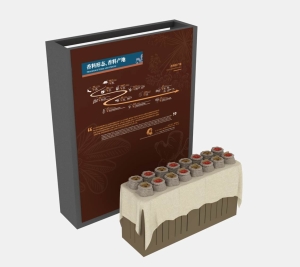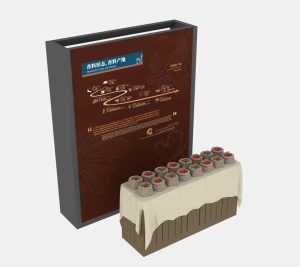接下来我们去右边,看看香料。从这里的展板上您可以发现,我们现在熟悉的很多香料,都是从国外传进来的。比如烧烤用的孜然,是来自埃及和埃塞俄比亚;迷迭香,来自地中海地区;檀香来自印度;藏红花来自希腊;就连茉莉花,也是从南亚、西亚传来的。中国原产香料少,但是对香料的需求却非常旺盛,房间里要有熏香,随身要带香囊,甚至在墓葬中,也要随葬香料,所以需要大量进口。
Now please make a right and you will see the spices. As you can see from the display panel here, many spices we are familiar with came from abroad. For example, cumin for barbecuing is from Egypt and Ethiopia; rosemary from the Mediterranean; sandalwood from India; saffron from Greece; and even jasmine from South Asia and West Asia. Ancient China produced few native spices itself but possessed a strong demand. They lit incense to scent their rooms, always carried a sachet around, and even buried spices in tombs as funerary objects, greatly prompting importing spices.
很多香料的原材料都是植物,很容易腐烂,所以把香料带上丝路之前,得先进行加工才行。常见的香料加工方式有三种,分别是风干、研磨和蒸馏。风干和研磨容易理解,而蒸馏法,是利用高温水蒸气,把香料的精油给提炼出来,然后装入容器就可以了。我们经常听说的玫瑰精油就是这么制作的。
As most spices are derived from plants, which decay quickly, merchants normally processed spices first before starting their trek along the Silk Road. The most common spice processing methods were air drying, grinding, and distillation. Air drying and grinding are quite easy to understand. Distillation utilizes high-temperature steam to extract essential oils from spices and then these extracts were bottled. The rose essential oil that we often hear about is made in this way.
有一些香料,也从中国出口到了西方,它们主要是一些用来烹饪食物的香料,比如肉桂、胡椒等等。
Despite its large spice imports, China also exported its own native spices to other countries. Its spice exports were primarily used in cooking, such as cinnamon and peppers.
那看了这么多商品,相信您作为“马可·波罗”,已经知道应该带哪些商品去中国了。
After seeing all these goods, I believe you can already surmise what to bring to China as Marco Polo.




















 京公网安备11010502039775号
京公网安备11010502039775号





